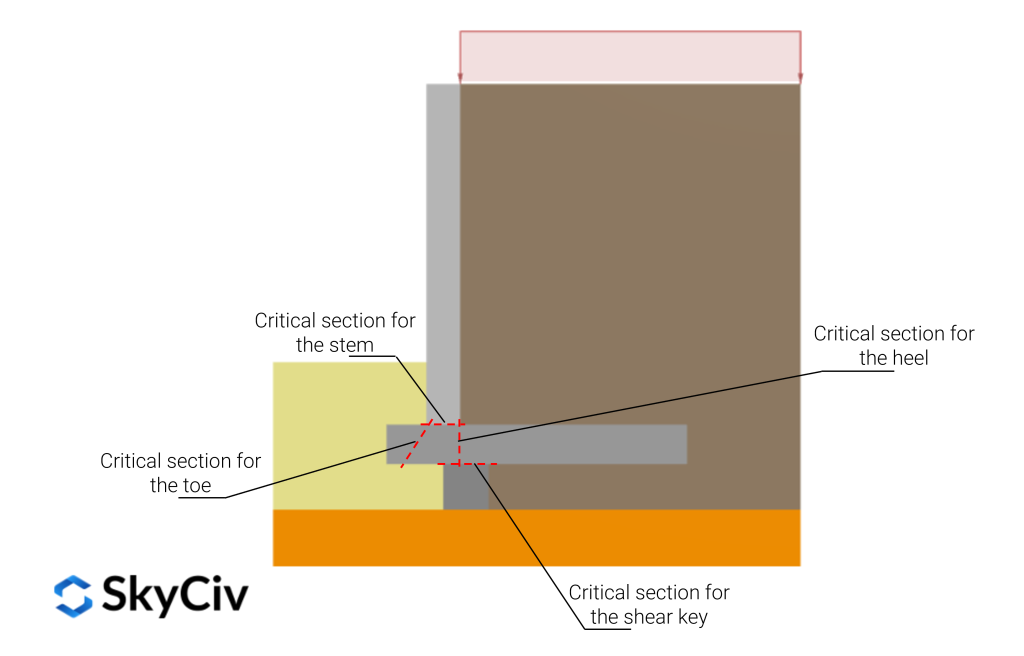根据 ACI 进行挡土墙设计检查 318-19
在混凝土悬臂挡土墙设计过程中, 第一步是定义 初步尺寸 并检查 稳定 这个初步几何反对 倾覆, 滑行, 和轴承. 完成这些稳定性检查涉及计算作用在挡土结构上的所有力. 那些负载, 考虑因素时, 是对混凝土挡土墙进行设计检查并确保尺寸和提供的钢筋所需的输入, 将能够承受极限状态载荷. 使用我们的挡土墙设计软件, 可以在混凝土挡土墙设计过程中执行所需的稳定性检查.
综上所述, 对混凝土挡土墙不同组件的设计检查包括:
- 干
- 临界区: 位于茎基部, 在挡土墙底座的表面. 用于剪切强度检查, ACI 318 允许远距离使用该部分 d 以基地为关键.
- 作用力: 滞留土壤主动压力和来自超载载荷的附加压力.
- 检查效果: 临界截面悬臂挡土墙杆部的弯曲和剪切.
- 脚跟
- 临界区: 位于立柱与墙基的交界处. 用于剪切强度检查, ACI 318 允许远距离使用该部分 d 从接口作为关键接口.
- 作用力: 保留土壤重量, 足跟自重, 和垂直附加费. 可以包括地基以下的土壤压力, 但通常因保守而被忽视.
- 检查效果: 悬臂挡土墙根部关键截面处的剪力和弯曲.
- 脚趾
- 临界区: 位于茎的表面. 用于剪切强度检查, ACI 318 允许远距离使用该部分 d 从茎的表面作为关键.
- 作用力: 承受脚趾下方的压力. 作用于脚趾以上的被动土自重通常被忽略, 因为它可能会腐蚀或被移除.
- 检查效果: 悬臂挡土墙趾部关键断面的剪力和弯曲.
- 剪切键 (如果包括)
- 临界区: 位于剪力键与墙基的交界处.
- 作用力: 被动土压力.
- 检查效果: 悬臂挡土墙关键断面剪力.

负载系数符合 ACI-318
根据 ACI-318 的要求对混凝土悬臂挡土墙进行设计检查时, 作用在结构上并在临界截面处产生内力的所有外力, 根据其性质考虑, 如下:
- 对于侧向土压力, 由于土壤的重量和附加载荷, 计算极限状态载荷的因子是 \(1.6\)
- 对于结构自重, 计算极限状态载荷的因子是 \(1.2\)
这些因素反映了超出计算值的概率 “精确的” 值, 对于结构自重的情况, 被超越的概率相当低, 因此该因子接近于 1.0, 然而, 保留土的重量、侧压力等外力以及附加费更有可能取较高的值, 这就是为什么负载因子更接近 2 比 1.
根据 ACI-318 的阻力降低系数
除了增加作用在结构上的力, 通过应用一些因素也可以降低其电阻, 遵循 LRFD (负载和阻力系数设计) 方法. 各电阻值减小如下:
- 用于抗弯曲, 假设该构件是张力控制的, 折减系数为 \(0.9\)
- 用于抗剪力, 折减系数为 \(0.75\)
设计要求符合 ACI-318
将最终状态内力与该内力的减少的构件阻力进行比较, 可以确定所提供的混凝土截面和预埋钢筋是否足够强度. 这可以用以下两个方程表示:
- 对于标称力矩阻力 \(M_n) 和极限状态矩 \(M_u\)
\(\φ \; M_n \geq M_u\)
- 对于标称抗剪力 \(V_n\) and ultimate state shear force\(V_u\)
\(\φ \; V_n \geq V_u\)
根据 ACI-318 的附加要求
除了满足上述要求外, ACI-318 提出了成功完成混凝土挡土墙设计的一些附加要求:
- 根据梁所需的最小弯曲钢筋检查计算出的结构任何部件的弯曲钢筋. 根据 ACI-318, 由于缺乏冗余,使用梁公式代替单向板公式:
\(一个_{s, \; 分} = frac{3 \sqrt{f'_c}}{f_y} b_w d\)
- 一旦计算出弯曲所需的钢材面积, 检查该部分以确保张力受控, 换句话说,确保钢筋在混凝土裂缝之前屈服:
\(\varepsilon_t = frac{\变体_c}{C}(直流) > 0.005\)
在哪里 \(c = 压裂{一个}{\测试版_1}\), \(a = 1.31 作为), \(\变体_c = 0.003\) (假设混凝土在该应变水平下出现裂缝), 和 \(d\) 是从受压边缘到受拉钢筋中心的距离.
- 计算悬臂混凝土挡土墙每个部件的最小横向钢筋面积, 使用表中给出的比率 11.6.1 ACI-318的
- 还计算悬臂混凝土挡土墙每个组件的展开长度和拼接长度, 使用中给出的标准 25.4.2 ACI-318的
SkyCiv 挡土墙计算器
SkyCiv 提供免费的挡土墙计算器,它将检查挡土墙的滑动并对挡土墙进行稳定性分析. 付费版本还显示完整的计算, 所以你可以一步一步看到, 如何计算挡土墙抗倾覆的稳定性, 滑动轴承! 使用付费帐户, 还可以根据 ACI 对挡土墙进行设计检查.
产品开发人员
ng (民用)
领英


